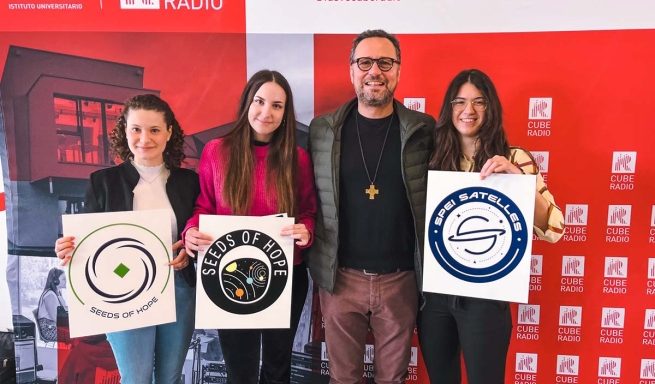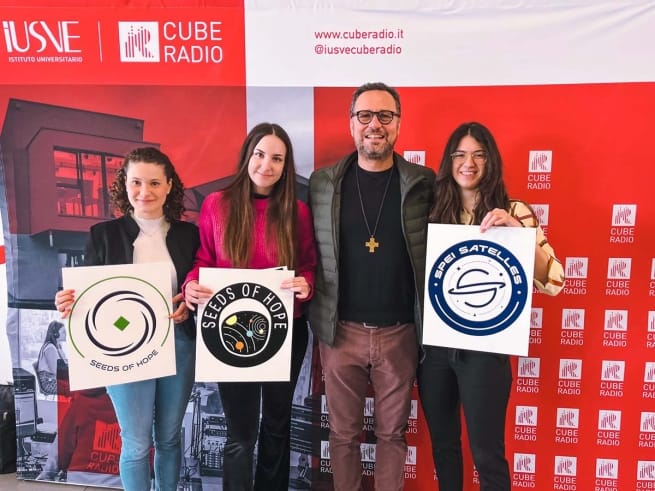(Istituto Universitario Salesiano de Venezia, Italia) – Messages of hope for all humanity, sent on a mission into orbit in the immensity of space. And these messages are enclosed in immensely small objects: a nano-library sent by a nano-satellite. On the third anniversary of the Statio Orbis – 27 March 2020, when the Pope implored an end to the pandemic with his solitary prayer in a rain-swept St. Peter’s Square – the ‘Spei Satelles’ space mission was born, from an idea of Monsignor Lucio Ruiz, secretary of the Dicastery for Communication, in collaboration with the Italian Space Agency, the Turin Polytechnic, the Institute of Photonics and Nanotechnology of the National Research Center and the Turin Digital Apostolate. In this historic event, the mission’s official logo is signed by IUSVE, and in particular by student Marica Padoan whose project met with the approval of the Spei Satelles working group and who will therefore accompany the message of hope into orbit.
It all began in January 2023 when “Cube Radio”, an academic radio station of the IUSVE, collected a collection of works of ingenuity produced in the educational sphere called “Seeds of Hope”, and selected, in addition to Marica’s logo, those of Anna Betteti and Margherita Girardi for a hypothetical virtual mission concerning the launch of a satellite. The characteristics of the mission mirrored, in part, those of Spei Satelles.
“I designed the logo from some Gestalt suggestions applied to the design,” explains Marica Padoan. “I looked for an overall result that was more effective than the sum of the various elements included. The logo unites the earth with the sky, the work of days during the pandemic, with hope that has no borders.” Manuel Masiero, a Communication student at IUSVE, also made the video explaining the mission. Starting with illustrations telling the story of the Statio Orbis, he narrated the stages of the project. “The digital laboratory that we set up within Cube Radio,” explains Marco Sanavio, Director of the IUSVE radio station, “allowed us to effectively contribute to the narrative of hope, which we had already started with our podcasts on 27 March 2020. Also contributing to the project’s communication was Matteo Contarin, Cube Radio’s official videomaker, who now has the task of creating the video storytelling of the mission, starting on 27 March.
“Being involved in this project,” concludes Father Nicola Giacopini, Director of IUSVE, “has allowed us to contribute to a mission that brings hope – first of all – here on earth, as well as projecting it beyond the horizon. Our Communication students and graduates have been very active in expressing the key concepts of the mission through graphics, images, and digital communication.”
The logo recalls the initials of Spei satelles, the guardian of hope. The two letters ‘S’, arranged in a specular manner, indicate the complementarity of ‘earth’ (the lower half-circle) and ‘sky’ (the upper half-circle), as well as marking the satellite’s orbit around our planet. Another outermost, dashed orbital track, composed of 59 lines as many as the beads of the rosary, unites three shapes: the cross (with its curved sides almost representing a star), the largest and most important element of the three, indicating the presence of Christ the Savior and Lord of the Universe; the 12-pointed star, symbolizing the presence of the Virgin Mary crowned by 12 stars (Rev 12:1); the smaller triangle, whose shape recalls that of the cross, recalls the figure of the Holy Father as he climbs the steps of the parvis of St Peter’s Square during the “Statio Orbis”. The three dots that appear on the outer orbital track are a sign of the presence of the Trinity in the universe, as is the threefold proclamation of the passion, death, and resurrection in the synoptic gospels, a message that gives hope to humanity.
Source: ANS – “Agenzia iNfo Salesiana”


